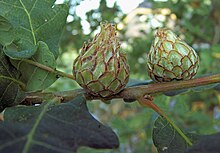| Andricus foecundatrix | |
|---|---|

| |
| Mature galls on pedunculate oak | |

| |
| Larva | |
| Scientific classification | |
| Domain: | Eukaryota |
| Kingdom: | Animalia |
| Phylum: | Arthropoda |
| Class: | Insecta |
| Order: | Hymenoptera |
| Family: | Cynipidae |
| Genus: | Andricus |
| Species: | A. foecundatrix
|
| Binomial name | |
| Andricus foecundatrix (Hartig, 1840)
| |
Andricus foecundatrix (formerly Andricus fecundator) is a parthenogenetic gall wasp which lays a single egg within a leaf bud, using its ovipositor, to produce a gall known as an oak artichoke gall, oak hop gall, larch-cone gall or hop strobile[1][2] The gall develops as a chemically induced distortion of leaf axillary or terminal buds on pedunculate oak (Quercus robur) or sessile oak (Quercus petraea) trees. The larva lives inside a smaller hard casing inside the artichoke and this is released in autumn. The asexual wasp emerges in spring and lays her eggs in the oak catkins. These develop into small oval galls which produce the sexual generation of wasps.[3][4] A yew artichoke gall caused by the fly Taxomyia taxi also exists, but is unrelated to the oak-borne species. Previous names or synonyms for the species A. fecundator are A. fecundatrix, A. pilosus, A. foecundatrix (see below), A. gemmarum, A. gemmae, A. gemmaequercus, A. gemmaecinaraeformis and A. quercusgemmae.
The scientific name is now once again Andricus foecundatrix.[5]
- ^ Arnold Darlington (1975). The Pocket Encyclopaedia of Plant Galls in Colour. Poole, Dorset: Blandford Press. pp. 156–157. ISBN 0-7137-0748-8.
- ^ "A Nature Observer's Scrapbook". Archived from the original on 2010-09-23. Retrieved 2008-03-15.
- ^ Galls on UK Safari
- ^ The Virtual Filed Guide UK Archived February 24, 2008, at the Wayback Machine
- ^ Redfern M, Shirley P, Bloxham, M (2011). British Plant Galls. Shrewsbury: Field Studies Council.